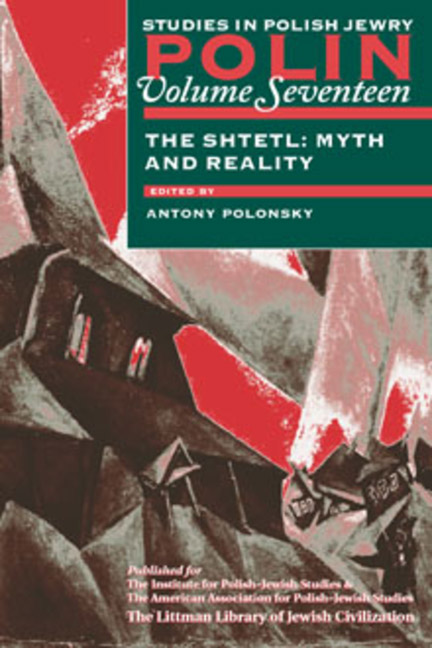Book contents
- Frontmatter
- Dedication
- Editors and Advisers
- Preface
- Polin
- Polin: Studies inPolish Jewry
- Contents
- Note on Place Names
- Note on Transliteration
- List of Abbreviations
- PART I THE SHTETL: MYTH AND REALITY
- Introduction. The Shtetl: Myth and Reality
- The Shtetl as an Arena for Polish–Jewish Integration in the Eighteenth Century
- Inter-Religious Contacts in the Shtetl: Proposals for Future Research
- The Hasidic Conquest of Small-Town Central Poland, 1754–1818
- The Drama of Berdichev: Levi Yitshak and his Town
- Polish Shtetls under Russian Rule, 1772–1914
- How Jewish Was the Shtetl?
- The Changing Shtetl in the Kingdom of Poland during the First World War
- The Shtetl: Cultural Evolution in Small Jewish Towns
- Small Towns in Inter-War Poland
- Jewish Patrons and Polish Clients: Patronage in a Small Galician Town
- Maintaining Borders, Crossing Borders: Social Relationships in the Shtetl
- The Soviet Shtetl in the 1920s
- Shtetl and Shtot in Yiddish Haskalah Drama
- Kazimierz on the Vistula: Polish Literary Portrayals of the Shtetl
- Imagining the Image: Interpretations of the Shtetl in Yiddish Literary Criticism
- Shtetl Codes: Fantasy in the Fiction of Asch, Schulz, and I. B. Singer
- Returning to the Shtetl: Differing Perceptions
- PART II NEW VIEWS
- PART III DOCUMENTS
- PART IV THE SIXTY-FIFTH ANNIVERSARY OF EVENTS IN PRZYTYK: A DEBATE
- PART V REVIEWS
- OBITUARIES
- Notes on the Contributors
- Glossary
- Index
Maintaining Borders, Crossing Borders: Social Relationships in the Shtetl
from PART I - THE SHTETL: MYTH AND REALITY
- Frontmatter
- Dedication
- Editors and Advisers
- Preface
- Polin
- Polin: Studies inPolish Jewry
- Contents
- Note on Place Names
- Note on Transliteration
- List of Abbreviations
- PART I THE SHTETL: MYTH AND REALITY
- Introduction. The Shtetl: Myth and Reality
- The Shtetl as an Arena for Polish–Jewish Integration in the Eighteenth Century
- Inter-Religious Contacts in the Shtetl: Proposals for Future Research
- The Hasidic Conquest of Small-Town Central Poland, 1754–1818
- The Drama of Berdichev: Levi Yitshak and his Town
- Polish Shtetls under Russian Rule, 1772–1914
- How Jewish Was the Shtetl?
- The Changing Shtetl in the Kingdom of Poland during the First World War
- The Shtetl: Cultural Evolution in Small Jewish Towns
- Small Towns in Inter-War Poland
- Jewish Patrons and Polish Clients: Patronage in a Small Galician Town
- Maintaining Borders, Crossing Borders: Social Relationships in the Shtetl
- The Soviet Shtetl in the 1920s
- Shtetl and Shtot in Yiddish Haskalah Drama
- Kazimierz on the Vistula: Polish Literary Portrayals of the Shtetl
- Imagining the Image: Interpretations of the Shtetl in Yiddish Literary Criticism
- Shtetl Codes: Fantasy in the Fiction of Asch, Schulz, and I. B. Singer
- Returning to the Shtetl: Differing Perceptions
- PART II NEW VIEWS
- PART III DOCUMENTS
- PART IV THE SIXTY-FIFTH ANNIVERSARY OF EVENTS IN PRZYTYK: A DEBATE
- PART V REVIEWS
- OBITUARIES
- Notes on the Contributors
- Glossary
- Index
Summary
BACKWARD AND FORWARD
IN the twenty-first century scholars debate a phenomenon that represented the absolute antithesis of postmodernity. ‘Represented’ because, though lasting for centuries, it was made abruptly extinct in the mid-twentieth century and is swiftly escaping living memory. Why does one study shtetl communities today? As Mark Zborowski and Elizabeth Herzog wrote in their Preface to Life Is with People, ‘It is a culture that is not remote. On the contrary, it is one with which many have had direct or indirect contact, through its representatives or their descendants.’ One might even venture to guess that the majority of those researching the topic have had just such contact, in Jewish as well as non-Jewish families. Increasingly there is a desire to return to one's memories or roots; individuals scattered over various continents are visiting places that were home for themselves or close kin. A new non-fiction genre—from Theo Richmond's Konin to Diane Armstrong's Mosaic to Shimon Redlich's Together and Apart in Brzeżany—serves as partial evidence of this.
Accompanying the nostalgia, however, is a desire to analyse a model of multiculturalism glaringly different from the one popularly propagated today—one in which, paradoxically, segregation instead of integration was the rule. In examining the shtetl, we find ourselves puzzled. Inconclusive are the debates in which historical methodology and thinking are applied to determine whether the shtetl was (to paraphrase Ezra Mendelsohn) good for the Jews or bad for the Jews, good for the Christians or bad for the Christians, or (to paraphrase Joel Berkowitz) a dystopia or a utopia.
Arguments for calling the shtetl ‘backward’ abound, of course, if one compares its living conditions to those of the Western world. Who would see as ‘forward’ the rarity of indoor plumbing, the dominance of dirt roads and dirt floors, or the nonexistence of mechanized public transportation? Moreover, these unenlightened folk seem to have been content with the way things were and seem not to have wanted to ‘progress’. This was a ‘traditional’ culture: a conservative society in which upholding and safeguarding the status quo was an ideal towards which all members of the group strove.
- Type
- Chapter
- Information
- The Shtetl: Myth and Reality , pp. 171 - 196Publisher: Liverpool University PressPrint publication year: 2004



